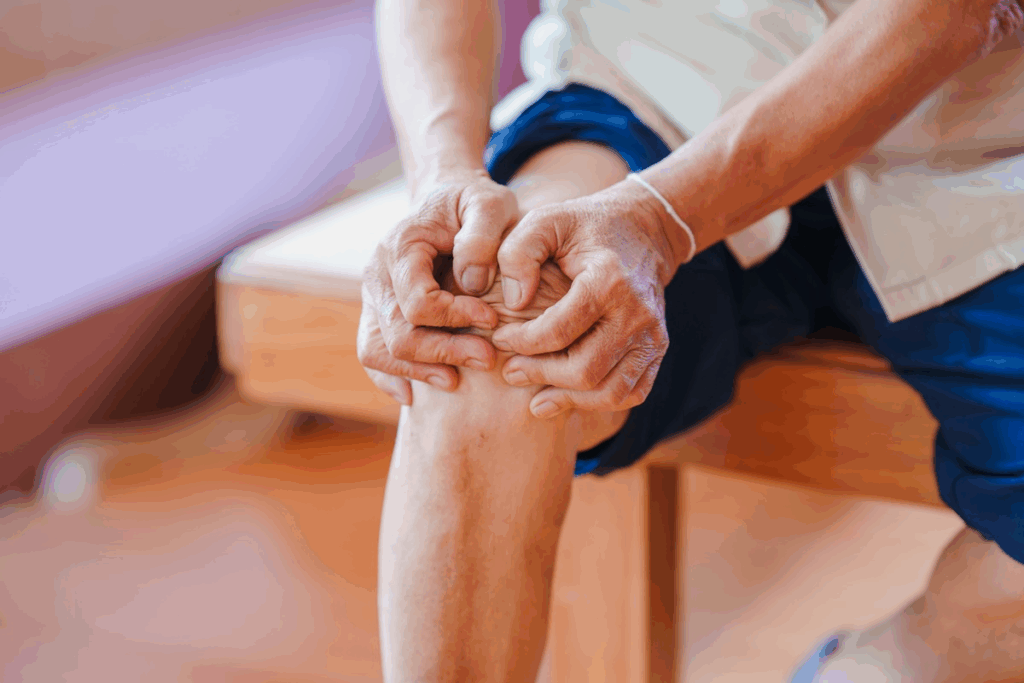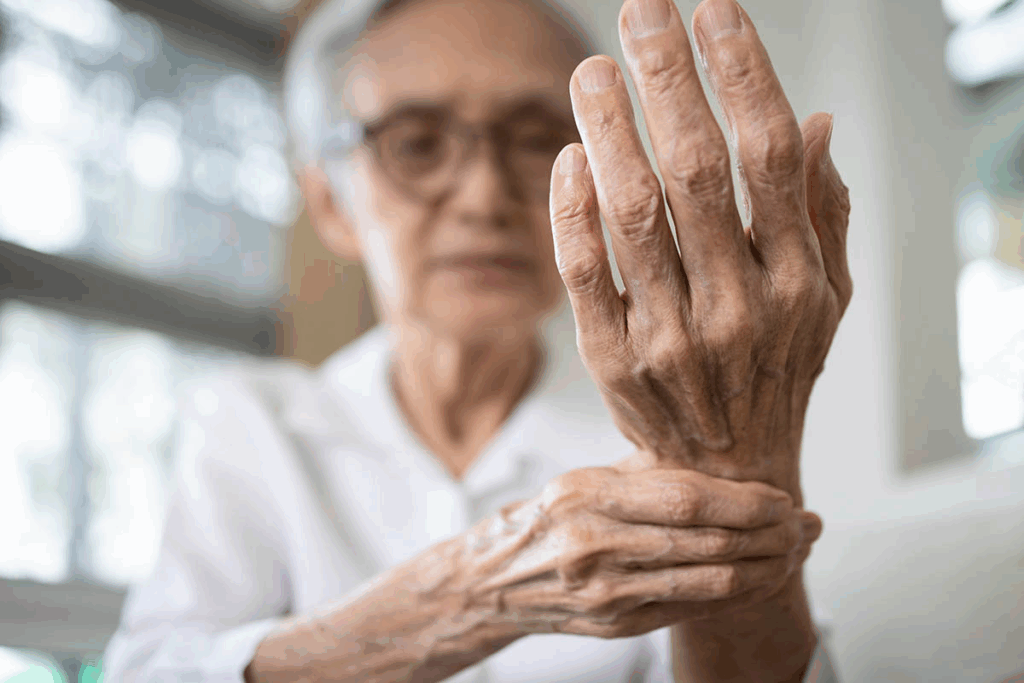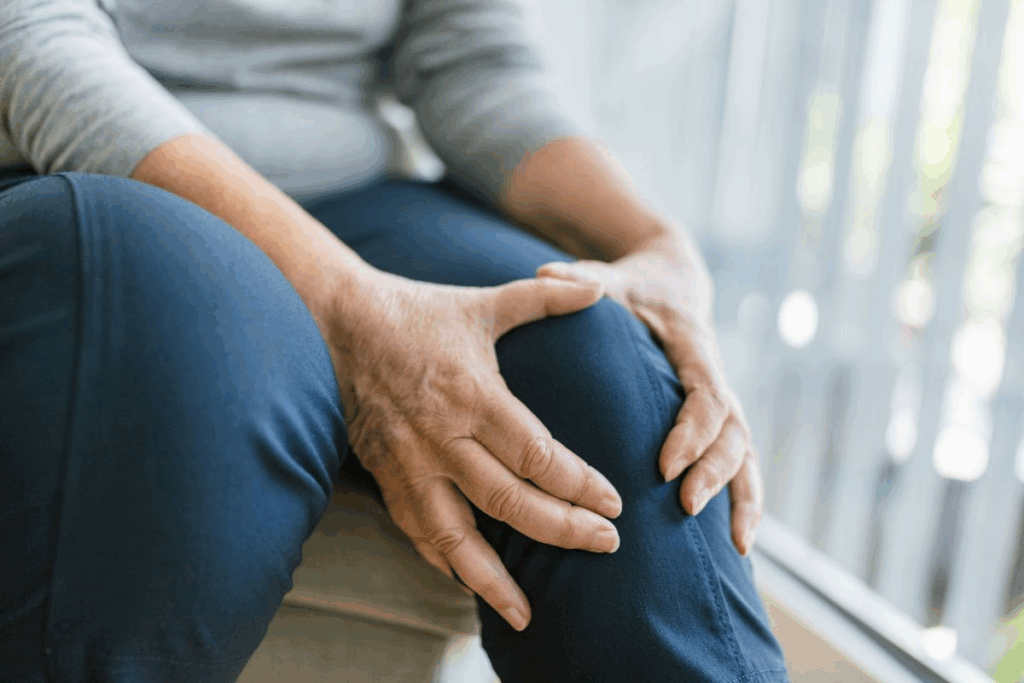Last Updated on October 21, 2025 by mcelik

Osteoarthritis (OA) affects over 32.5 million adults in the United States. It’s the most common form of arthritis. It happens when the cartilage between bones breaks down, leading to joint pain.
Understanding osteoarthritis is crucial for effectively managing its symptoms and slowing its progression.
By understanding what causes osteoarthritis, people can take steps to lessen their symptoms. This can also slow down the disease’s progress.

Understanding osteoarthritis is crucial for effectively managing its symptoms and slowing its progression. Osteoarthritis (OA) is a disease where cartilage breaks down. This leads to bone-on-bone contact and a lot of pain.
In osteoarthritic joints, cartilage wears down over time. This causes bones to rub against each other, leading to pain, swelling, and less mobility. The loss of cartilage also causes bone changes, like bone spurs, which make the condition worse.
“Osteoarthritis is not just a wear-and-tear disease; it’s a complex condition involving joint inflammation, cartilage degradation, and bone changes.”
People with osteoarthritis often feel joint pain, stiffness, and have trouble moving. These symptoms can get worse over time, leading to disability. How fast OA gets worse can vary a lot from person to person.
| Symptom | Description | Impact on Daily Life |
| Joint Pain | Pain in the affected joint(s) during movement or at rest | Limits activity and affects sleep |
| Stiffness | Increased stiffness, particular after rest | Makes it difficult to start moving |
| Limited Mobility | Reduced range of motion in the affected joint(s) | Affects daily tasks |
Managing triggers is key to slowing OA and easing symptoms. Triggers include being overweight, repetitive movements, and certain foods. By avoiding these triggers, people can live better lives.
Effective management strategies include lifestyle changes like losing weight and exercising differently. Medical help, like pain meds and sometimes surgery, can also be part of the plan.

Knowing what worsens osteoarthritis is key to managing it well. People with osteoarthritis often need to change their lifestyle a lot. This helps them live better with their condition.
Many things can make osteoarthritis symptoms worse. Joint overuse and obesity are big ones. Using joints too much can wear them down fast. Being overweight adds extra pressure on joints like knees and hips, speeding up damage.
Being overweight also causes more inflammation in the body. This makes managing osteoarthritis harder. The link between fat and joint health is very important.
Things like joint overuse and obesity make osteoarthritis get worse faster. When joints are stressed too much, cartilage breaks down quickly. This leads to more pain and less mobility.
| Trigger | Effect on Joint Health | Disease Progression Impact |
| Joint Overuse | Increased wear and tear | Accelerated cartilage deterioration |
| Obesity | Additional mechanical load and systemic inflammation | Enhanced joint damage and pain |
Triggers for osteoarthritis can differ a lot from person to person. Some might feel worse from using their joints too much. Others might be more affected by being overweight or other things.
To manage osteoarthritis well, you need a plan that fits you. Knowing and dealing with your specific triggers and risks helps control symptoms. It also slows down how fast the disease gets worse.
Excess body weight is a major cause of osteoarthritis. This disease affects millions and is linked to a healthy weight for symptom management.
Being overweight adds stress to joints like knees, hips, and spine. This stress speeds up cartilage wear, causing pain and stiffness.
Obesity increases joint stress, mainly in the lower body. For every pound, knee joint stress goes up, making walking hard for those with OA.
Table: Impact of Body Weight on Knee Joint Stress
| Body Weight (lbs) | Force on Knee per Step (lbs) |
| 150 | 450-600 |
| 200 | 600-800 |
| 250 | 750-1000 |
Excess fat also causes chronic inflammation, which worsens OA. Fat tissue releases substances that increase joint inflammation and damage.
A Mediterranean diet rich in plants, fiber, and healthy fats can help manage OA symptoms by reducing inflammation. Foods like oily fish, fruits, and vegetables have anti-inflammatory effects.
Weight loss is key for OA management, for those who are overweight or obese. Losing just a bit of weight can greatly improve symptoms and joint function.
Research shows losing 5% of body weight can improve joint pain and function. This is because it reduces joint stress and inflammation.
Repetitive movements and joint overuse can make osteoarthritis symptoms worse. People with osteoarthritis should know how daily activities and work or sports affect their joints.
Jobs that involve repetitive tasks or heavy lifting can raise the risk of osteoarthritis. For example, jobs that require bending, kneeling, or heavy lifting can stress joints, like knees, hips, and lower back.
Examples of high-risk occupations include:
Playing sports that involve high-impact activities or repetitive joint movements can also lead to osteoarthritis. Running, jumping, and tennis can be hard on the joints.
“The repetitive impact and stress on joints from certain sports can accelerate the wear and tear associated with osteoarthritis.”
Understanding osteoarthritis is crucial for effectively managing its symptoms and slowing its progression.
Strategies for balancing activity and rest include:
By understanding the risks of joint overuse and repetitive movements, people with osteoarthritis can manage their condition better. This can improve their quality of life.
A sedentary lifestyle can make osteoarthritis symptoms worse. It makes everyday tasks harder. For those with osteoarthritis, regular exercise is key to keeping joints healthy and feeling good overall.
Not exercising can weaken the muscles around joints with osteoarthritis. When these muscles are weak, joints take more stress. This leads to more pain and less mobility. Exercises can strengthen these muscles and ease joint pressure.
Benefits of Exercise for Joint Health:
Understanding osteoarthritis is crucial for effectively managing its symptoms and slowing its progression.
Understanding the Cycle:
| Cycle Stage | Effect on Osteoarthritis |
| Pain | Reduces mobility due to discomfort |
| Reduced Mobility | Increases stiffness and reduces muscle strength |
| Increased Stiffness and Weakness | Exacerbates pain, continuing the cycle |
Understanding osteoarthritis is crucial for effectively managing its symptoms and slowing its progression.
Recommended Exercises:
Understanding osteoarthritis is crucial for effectively managing its symptoms and slowing its progression.
Certain high-impact activities can make osteoarthritis symptoms worse. They can also speed up joint damage. When people with osteoarthritis do activities that stress their joints too much, it can cause more pain and disease progression.
Running, jumping, and heavy lifting are bad for people with osteoarthritis. These activities put too much stress on the joints. This can lead to more cartilage damage and inflammation.
Be careful with these activities:
It’s key to use proper form and technique in physical activities. This helps avoid straining joints. Even low-impact activities can be harmful if done wrong.
| Activity | Proper Technique | Common Mistakes |
| Weightlifting | Keep back straight, lift with legs | Rounding back, using back instead of legs |
| Running | Land midfoot, keep posture upright | Heel striking, slouching |
| Cycling | Adjust seat height, keep knees slightly bent | Seat too low or too high, straining knees |
There are low-impact alternatives for those who like to stay active. These activities are good for joints without the strain of high-impact ones.
Good low-impact activities include:
The food we eat is key in managing osteoarthritis. Some diets can make the condition worse. A diet full of processed foods, sugars, and unhealthy fats can cause more inflammation. This makes osteoarthritis symptoms worse.
Some foods can trigger or make inflammation worse. Red meat, fried foods, and foods with a lot of sugar are examples. Eating these foods often can make joints hurt and stiffen.
Common Pro-Inflammatory Foods:
A diet without important nutrients can harm joints. Not getting enough vitamins D and K, omega-3 fatty acids, and antioxidants can cause more inflammation and damage to joints.
| Nutrient | Role in Joint Health | Food Sources |
| Vitamin D | Maintains bone health | Fatty fish, fortified dairy products |
| Omega-3 Fatty Acids | Reduces inflammation | Salmon, walnuts, chia seeds |
| Antioxidants | Protects against oxidative stress | Fruits, vegetables, nuts |
Following an anti-inflammatory diet can help with osteoarthritis symptoms. Eating foods rich in omega-3 fatty acids, antioxidants, and fiber can reduce inflammation.
Benefits of an Anti-Inflammatory Diet:
By choosing the right foods, people with osteoarthritis can manage their symptoms better. This can improve their quality of life.
The link between weather and osteoarthritis pain is complex. Many with osteoarthritis say their pain changes with the weather. Cold temperatures and barometric pressure shifts are key factors.
Studies show weather changes can alter joint pressure. This can make joint fluid expand or contract, irritating nerves and causing pain. Cold weather also makes muscles and tendons stiffer, adding to discomfort.
Barometric pressure changes play a big role. When pressure drops before a storm, joint pressure increases, leading to pain and stiffness. The exact reasons are not fully known, but it’s clear weather affects osteoarthritis symptoms.
To manage osteoarthritis symptoms during weather changes, a proactive approach is needed. Here are some strategies:
For some, moving to a warmer climate might help manage osteoarthritis symptoms. But, this decision involves many factors beyond health.
It’s vital for osteoarthritis patients to work with their healthcare providers. They should develop a management plan that considers environmental factors and more.
Managing osteoarthritis goes beyond just medicine. It also involves making lifestyle changes. Quitting smoking, managing stress, and getting enough sleep are key for those with osteoarthritis.
Smoking is bad for your health, including osteoarthritis. It makes the disease worse and harder to manage. Smoking harms connective tissues and cuts off blood flow, which is needed for healing. It also boosts inflammation, making osteoarthritis symptoms worse.
Studies show smoking raises the risk of osteoarthritis, mainly in hands and knees. Giving up smoking can greatly improve your health and slow osteoarthritis.
“Smoking cessation is key for osteoarthritis patients, as it lowers disease risk and boosts health outcomes.”
– Journal of Orthopaedic Research
Stress also affects osteoarthritis. Chronic stress increases body inflammation, making osteoarthritis symptoms worse. Stress also makes pain feel worse.
Using stress-reducing activities like meditation, yoga, or deep breathing can help. Lowering stress can reduce inflammation and improve pain tolerance.
Good sleep is vital for health, including osteoarthritis. Sleep helps the body fix and grow back damaged tissues. Bad sleep or not enough sleep can make pain and inflammation worse.
Getting a regular sleep schedule and a good sleep environment can help. Avoiding caffeine and screens before bed also improves sleep.
| Lifestyle Factor | Impact on Osteoarthritis | Management Strategy |
| Smoking | Increases inflammation and impairs healing | Smoking cessation programs |
| Stress | Heightens pain perception and increases inflammation | Stress management techniques like meditation and yoga |
| Sleep Deprivation | Increases pain sensitivity and inflammation | Improving sleep hygiene and establishing a consistent sleep schedule |
Managing osteoarthritis well needs quick medical help and full care. If not treated, it can cause serious joint damage. This greatly affects how well you live.
Ignoring early signs of osteoarthritis can be very harmful. Untreated osteoarthritis can make joints worse, increase pain, and lower how well you can move.
The bad effects of ignoring early signs include:
Bad pain management can make osteoarthritis symptoms worse. Just using pain meds without fixing the root cause can lead to untreated joint pain osteoarthritis. This makes the disease get worse.
“The goal of osteoarthritis management is not just to alleviate symptoms but to slow disease progression and improve quality of life.”
– Arthritis Foundation
A detailed treatment plan is key for handling osteoarthritis well. It should mix lifestyle changes, physical therapy, and medical steps that fit the person’s needs.
The main parts of a good treatment plan are:
With a full approach, people with osteoarthritis can handle their symptoms better. They can also slow down how fast the disease gets worse.
Managing osteoarthritis starts with a joint-friendly lifestyle. Knowing what triggers symptoms helps people make better choices. This can ease their condition.
Handling osteoarthritis means more than one thing. It’s about keeping a healthy weight and doing the right exercises. Avoiding hard exercises is also important. Eating foods that fight inflammation is key to joint health.
By changing your lifestyle and watching out for things like weather and stress, you can feel better. A joint-friendly lifestyle is essential for managing osteoarthritis. It helps people live more active and happy lives.
Things that worsen osteoarthritis include overusing joints, being overweight, and not being active. High-impact activities, a bad diet, smoking, stress, and cold weather also play a role.
Being overweight puts more pressure on joints like hips, knees, and spine. This speeds up the wear and tear seen in osteoarthritis.
Yes, activities that are hard on joints can make osteoarthritis symptoms worse. This is because they add extra stress to the joints.
Yes, not being active weakens the muscles around joints. This can lead to a cycle of pain and not being able to move.
Eating foods that cause inflammation can make osteoarthritis symptoms worse. But, foods rich in omega-3s and antioxidants can help.
Yes, weather changes, like cold weather, can affect osteoarthritis symptoms. So can changes in barometric pressure.
Smoking hinders healing, increases inflammation, and can make osteoarthritis symptoms worse.
Stress can make inflammation and pain worse. This makes osteoarthritis symptoms more severe.
Good sleep is key for joint health. It helps reduce inflammation and aids in healing.
Delayed treatment can cause more joint damage, pain, and disability. This makes managing osteoarthritis harder.
To manage osteoarthritis well, keep a healthy weight, exercise gently, eat anti-inflammatory foods, manage stress, and sleep well. Making these lifestyle changes helps.
Yes, exercises like swimming, cycling, and yoga are safe and good for osteoarthritis patients.
Yes, untreated joint pain can be a sign of joint damage. If not managed, it can lead to osteoarthritis.
Dehydration can make osteoarthritis symptoms worse. It reduces joint lubrication and health.
Using the right form and technique is key to avoiding joint strain. It also helps prevent osteoarthritis from getting worse.
Subscribe to our e-newsletter to stay informed about the latest innovations in the world of health and exclusive offers!
WhatsApp us